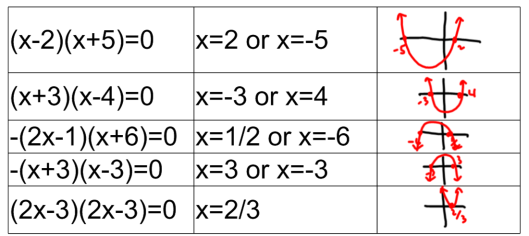I just returned from NCTM Nashville and wanted to put some things I’d learned into practice immediately before I forgot about them. One of those was from @k8nowak and the idea of inverting a lesson. Unfortunately (thanks to the lovely Nashville traffic) I didn’t make it to her session, but I was able to chat with a friend who was able to fill me in. The big idea, as I understand it, is to invert the order of a traditional lesson by giving students a “puzzle” then asking them to continue it or add to it. The generalizations or rules are saved for the end, after everyone is familiar with what is happening in the problems. Here is my version of it…
Our topic: the zero-product property
Students already know how to factor quadratics
What I did:
I started class by showing this this chart, and briefly explaining what it meant; namely, that everything on the slide was true, and that there were no problems for them to work out. Instead, I was giving them the problem, the answer, and what those two pieces of information told me about the graph of the function.

I asked them to study the chart silently for 1 minute, then turn and share their observations with their neighbor for 1 minute. Students then had a small white board on which I asked them to respond to questions similar to these:
Make up a new problem, solution, and graph that could be added to my list. [After viewing their responses, I selected 3 to add to the list above]
Make up a problem that would have 2 positive solutions. [Again, adding a couple selections to the list]
Make up a problem that would have a graph that opened downward. [Yep, add a couple more].
Make up a problem that would have one non-integer solution [Once we finally agreed on what-in-the-world I meant by that difficult vocabulary–insert sarcastic grimace- we had the opportunity to talk about why a factor of (x-1/2) is correct, but most likely would not present it self in that form. Students quickly figured out that it would be (2x-1) in most contexts]
After several questions and responses, and once I was fairly confident that the students knew what they were doing, we took some summarizing notes. Here’s the cool part: they didn’t really need me for this part. They knew what was going on and were able to put it in their own words. Rest assured math friends, I went over it, making sure we used good vocabulary and had solid examples to refer back to, but they had it.
So, from there, I asked them what they thought might be done to make the problems a bit more challenging. Because, let’s face it, that was pretty simple. It didn’t take more than 10 seconds for someone to say “put something besides zero on the right side of the equation” and about 25 seconds for someone else to say “give it to us un-multiplied” (we are still working on developing that vocabulary). Anyway, what a great natural sequence of events for me to give them more challenging problems. AND THEY WERE READY FOR IT!!
Just to complete everything properly, I gave them the following:
Thanks @k8nowak for sharing this approach and giving me a way to help my students “discover” mathematical concepts.
**Circuit training was a new term for a style of sequencing problems learned at NCTM from a session by Virginia Cornelius.